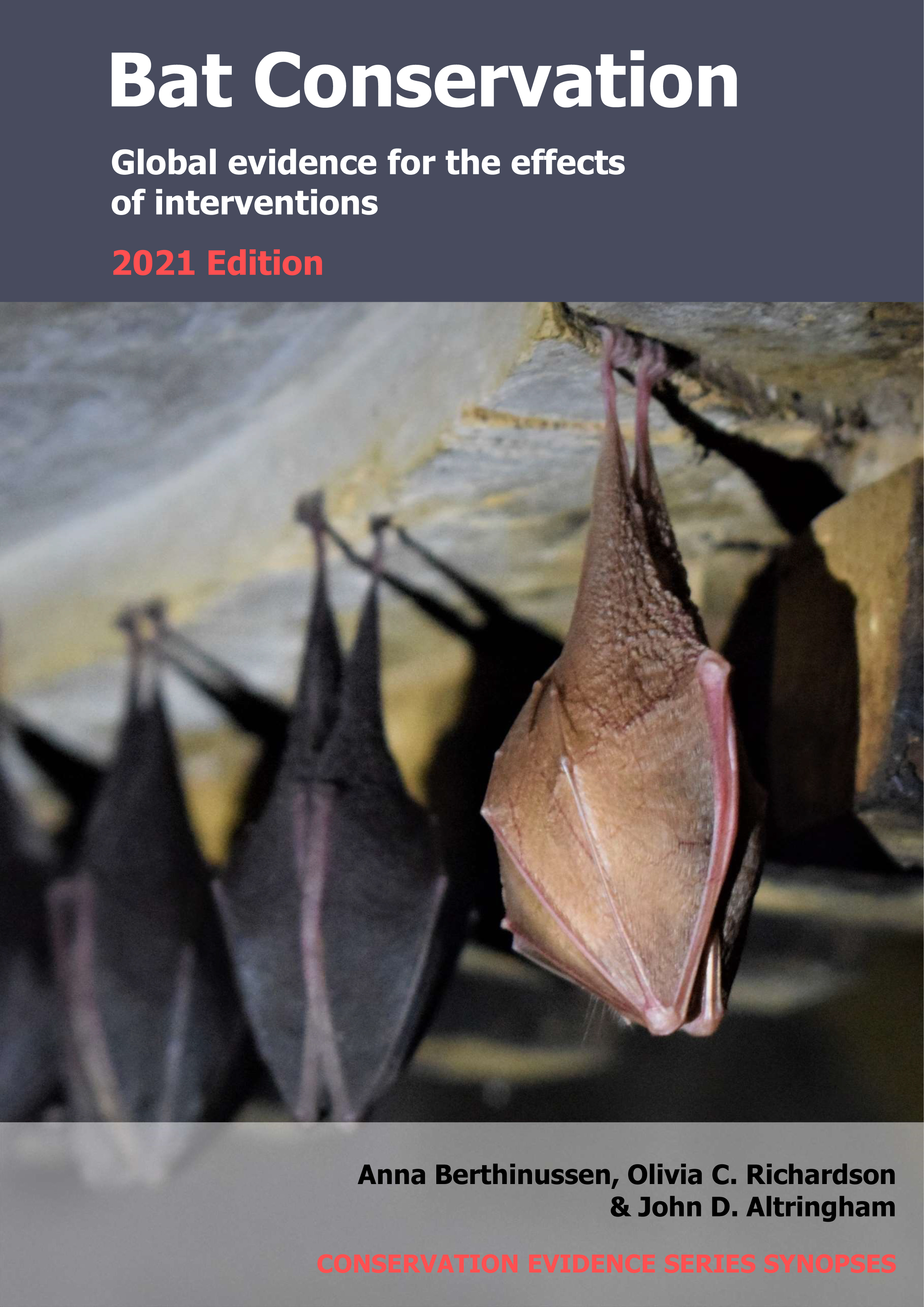Actions to conserve biodiversity
We have summarised evidence from the scientific literature about the effects of actions to conserve wildlife and ecosystems.
Review the evidence from the studies
Not sure what Actions are? Read a brief description.
Search for evidence
e.g. "frogs chytrid"
200 Actions found
Refine
Hide
200 Actions found
Download Actions
| 0 selected |
|
Order results by:
| Action | Effectiveness | Studies | Category | |
|---|---|---|---|---|
|
Create artificial water sources Action Link |
Likely to be beneficial | 5 |
|
|
|
Create new unlit commuting routes using planting Action Link |
No evidence found (no assessment) | 0 |
|
|
|
Create or maintain small dams to provide foraging and drinking habitat for bats Action Link |
Unknown effectiveness (limited evidence) | 1 |
|
|
|
Create or restore bat foraging habitat in urban areas Action Link |
Unknown effectiveness (limited evidence) | 3 |
|
|
|
Create spaces for roosting bats in road/railway bridges and culverts Action Link |
Likely to be beneficial | 1 |
|
|
|
Create tree plantations on agricultural land Action Link |
Unknown effectiveness (limited evidence) | 3 |
|
|
|
Cull bats infected with white-nose syndrome Action Link |
No evidence found (no assessment) | 0 |
|
|
|
Decontaminate clothing and equipment after entering caves to reduce the spread of the white-nose syndrome pathogen Action Link |
No evidence found (no assessment) | 0 |
|
|
|
Deter bats from roads/railways using lighting Action Link |
No evidence found (no assessment) | 0 |
|
|
|
Deter bats from roads/railways using ultrasound Action Link |
No evidence found (no assessment) | 0 |
|
|
|
Deter bats from turbines using low-level ultraviolet light Action Link |
No evidence found (no assessment) | 0 |
|
|
|
Deter bats from turbines using radar Action Link |
No evidence found (no assessment) | 0 |
|
|
|
Deter bats from turbines using ultrasound Action Link |
Unknown effectiveness (limited evidence) | 4 |
|
|
|
Direct lighting away from bat access points or habitats Action Link |
No evidence found (no assessment) | 0 |
|
|
|
Divert bats to safe crossing points over or under roads/railways with plantings or fencing Action Link |
Unknown effectiveness (limited evidence) | 1 |
|
|
|
Educate farmers, land managers and local communities about the benefits of bats to improve management of bat habitats Action Link |
No evidence found (no assessment) | 0 |
|
|
|
Educate farmers, local communities and pest controllers to reduce indiscriminate culling of vampire bats Action Link |
No evidence found (no assessment) | 0 |
|
|
|
Educate homeowners about building and planning laws relating to bats to reduce disturbance to bat roosts Action Link |
No evidence found (no assessment) | 0 |
|
|
|
Educate pest controllers and homeowners/tenants to reduce the illegal use of pesticides in bat roosts Action Link |
No evidence found (no assessment) | 0 |
|
|
|
Educate the public to improve perception of bats to improve behaviour towards bats Action Link |
No evidence found (no assessment) | 0 |
|
|
|
Encourage natural regeneration in former plantations Action Link |
No evidence found (no assessment) | 0 |
|
|
|
Encourage online vendors to remove bat specimens for sale Action Link |
No evidence found (no assessment) | 0 |
|
|
|
Enforce regulations to prevent trafficking and trade of bats Action Link |
No evidence found (no assessment) | 0 |
|
|
|
Engage farmers and landowners to manage land for bats Action Link |
Unknown effectiveness (limited evidence) | 1 |
|
|
|
Engage policymakers to make policy changes beneficial to bats Action Link |
No evidence found (no assessment) | 0 |
|
Download Actions
| 0 selected |
|

Bat Conservation - Published 2021
Update 2020
Watch this search
If you are familiar with RSS feeds, please click the button below to retrieve the feed URL:
RSS feed for this searchIf you are unfamiliar with RSS feeds, we would suggest reading this BBC article.
Unfortunately, due to the number of feeds we have available, we cannot provide e-mail updates. However, you could use tools such as Feed My Inbox to do this for you.
What are 'Individual studies' and 'Actions'?
Individual studies
An individual study is a summary of a specific scientific study, usually taken from a scientific journal, but also from other resources such as reports. It tells you the background context, the action(s) taken and their consequences.
If you want more detail please look at the original reference.
Actions
Each action page focuses on a particular action you could take to benefit wildlife or ecosystems.
It contains brief (150-200 word) descriptions of relevant studies (context, action(s) taken and their consequences) and one or more key messages.
Key messages show the extent and main conclusions of the available evidence. Using links within key messages, you can look at the paragraphs describing each study to get more detail. Each paragraph allows you to assess the quality of the evidence and how relevant it is to your situation.
Where we found no evidence, we have been unable to assess whether or not an intervention is effective or has any harmful impacts.





)_2023.JPG)














